The Unbearable Melancholy of Dining Alone: Buffalo Edition
No members of the Bills Mafia were harmed - or even mentioned - in the writing of this essay
This is a free post made possible by paid subscribers.
Writing is my profession and calling. If you find value in my work, please consider becoming a subscriber to support it.
Already subscribed but want to lend additional patronage? Prefer not to subscribe, but want to offer one-time support? You can leave a tip to keep this project going by clicking the link of your choice: (Venmo/Paypal/Stripe)
Thank you for reading, and for your support!
The rain started somewhere just south of Syracuse, and it alternated between drizzling and pouring for the last few hours of the drive.
I’d started the morning in sunny Portsmouth, just as the unseasonably warm temperatures were beginning to subside, yielding to the cooler weather of autumn at last. I’d spent a week and a half there with my friend
and his family. Problem was, I was getting a little too comfortable. I felt something stirring, deep within, prodding me onward. Truthfully, I didn’t really want to continue the trip. Comfort, routine, familiarity…these were what I craved. But they also served as a direct countervailing force, suppressing this strange but irresistible call into the unknown, to encounter whatever it is that I am being pulled out of myself to find there.Rhode Island was incredible. I vaguely recalled going to Misquamicut a handful of times as a kid, growing up in Connecticut, on the rare occasions we took family outings to the beach. But I’d never really spent much time in the aptly-named “Ocean State,” where a variety of different beaches are never more than a short drive away.
(I need more time to process that part of the trip, so I’ll be writing about it out of order as time permits.)
I made a point of avoiding long goodbyes, packing my car with as much efficiency as I could muster and forcing myself out onto the road. By 10AM, I was in Providence, and heading northward through Massachusetts. By mid afternoon, I was in New York.
I was disappointed to realize, as I stared out the windshield at the rolling, tree-covered hills, that I had arrived at least a week too early for the total display of nature’s fireworks. I’d been away from the Northeastern United States for the past few Octobers, so I was sad to notice that the familiar riot of fall colors had not fully arrived. The reds and yellows and oranges were slightly muted, and still interspersed with earthy green. But it would be here soon, I knew, and as my trip curved Westward into Ohio and Michigan, I expected I’d still have the chance to see the unrestrained glory of the autumnal show.
My little mid-sized sedan drives nicely, but it’s cramped quarters for my 6’4” frame. At a rest stop somewhere in the Mohawk Valley, I took a walk to stretch my legs, and the path wound around towards a canal and lock system — still in operation — just fifty yards or so behind the building.
I was born in Upstate New York, and spent more than half my childhood there. There’s something in the landscape, the weather, the rustic old towns, the look and feel of the foliage, that will always carry the strange, sad echo of home.
My next multi-day stop was in central Michigan, but I’d failed to get a passport before leaving North Carolina, so I couldn’t take the expedited route through Canada. That would have shaved off at least two hours from this leg of the trip. The America-only route was a roughly 13 hour drive without stops, and in my middle age, I’ve come to realize that the stops are indispensable. The little roadside attractions, the coffee refills, the restroom breaks, the brief walks to get the blood moving and take in some fresh air — this is the connective tissue that holds a road trip together.
I didn’t have a clear plan when I left Rhode Island, so I figured it out on the road. By the time I was a couple hours into the drive, I had decided that Buffalo, New York, would be the best stopover for the night. Problem was, even the low-end hotels were pricey. On a whim, I checked Airbnb, and was pleasantly surprised to find an unbelievably cheap Airbnb nestled inside an old, converted “temple.” I didn’t know for sure what kind of temple it had been, but the room looked like it would do the trick. It was basically just a bed, a toilet, a shower, and a television, but I’m just one guy, so what more could I need? I certainly couldn’t argue with $65 for the night — even cheaper than a Motel 6. The last one of those I stayed in smelled like someone had gone around urinating on everything in the room. This place looked clean and comfortable, and had great reviews.
I pulled into town about an hour before sunset.
In my correspondence with the Airbnb host, I learned that the room I had booked was part of a nonprofit, the proceeds from which were being used to fund nutrition-based ADHD research in conjunction with NASA.
“Who knew,” she asked via the app’s messaging system, “that astronauts get the equivalent of ADHD after two months in microgravity? NASA calls it SANS. (Space Associated Neuro-Ocular Syndrome).”
As someone with ADHD who is also fascinated by space, the coincidence felt so on the nose that it struck me as some kind of cosmic breadcrumb, a little clue from God or the universe that I was hot on the trail of whichever ontological Carmen Sandiego-analog I was supposed to be tracking down.
The building was enormous. The prominent bas-relief Star of David carved into the masonry arch that crowned the structure and again on the frieze just above the main doors answered my question about what kind of temple it had once been. But its history turned out to be more complicated than that.
It stood out on a residential street full of early-20th-century American Foursquare and late Queen-Anne-influenced homes; boxy houses with prominent front porches, crowded together, worn by weather and time, surrounded by mature trees, and lit by the soft glow of incandescent street lamps.
I realized that the booking had come with a description and a bit of history. I just hadn’t opened the link. It gave me the backstory I needed on how it had come to be what it was now being used for:
The building was a Jewish Synagogue between 1911 and 1967. It became a Christian Church from 1967 to 2017. The Thomas family purchased it from the bank when the Church sadly fell on hard times.
2017–2023 – Restoration and Development into a purpose-built sanctuary for researchers. The restoration incorporated only high-quality, environmentally friendly materials. Our goal was to help researchers have a place to live and work here in Buffalo, in a better environment than either California or Boston. Our focus is on the mind and spirit through athletics and education.
The best local craftsmen, engineers, and architects were involved in the five-year, $10 million project. We reached out to the AKG and the Buffalo Art Museum to find talented local artists for our project. An upcoming painter and sculptor, Scott Carpenter, is the artist whose work appears in both common areas and individual lofts. Notably, he painted the beautiful icons in the office area of the sanctuary. We look forward to sculpting the trunk of the original elm tree in front of the building.
Current Architects – Kevin Conners of Eco-Logic and Seth Amann from Arch & Type & UB Professor.
Did you know that Richmond Avenue was designed by the architect Frederick Olmsted, who also designed the iconic Central Park in New York City?
I’d never been inside a synagogue of any kind, so I was quite literally stepping into an unknown world.
Well, I would be. If I could figure out how to get inside.
The instructions were very thoughtfully written, and carried within them a playful sense of wonder:
If you look at the back of the building, go down the left-hand side, which is opposite to the driveway, to a single wooden door with a window and a nuclear fallout sign on the wall — how cool is that?
I parked my car in the back, and since it was still raining, decided to figure out where the heck I was going before getting any of my stuff out.
At first, I went the wrong way. The walkway on the left-hand side was so well hidden by the building’s proximity to the adjoining fence that I didn’t even see it. But fortunately, I remembered how to read, re-checked the directions, and made my way back to that narrow path.
There were multiple doors along the way with keypads, but none of them were wooden, and none had a nuclear fallout sign on the wall. I couldn’t see a wooden door anywhere, but the building was not perfectly square, with alcoves and outcroppings of brick that obscured my view.
I kept walking.
Finally, near the front of the building, I found it, set back into the building wall in such a way that it was only visible if you were standing directly in front of it:
I entered the provided keycode, then continued with the instructions:
Go inside the door, and immediately you’ll notice the name BEN on your door. Do you know what BEN means in Hebrew?
“No, actually, I don’t.” I thought. I pulled out my phone and looked it up:
The description continued:
“Ben” can also refer to a broader sense of lineage, including grandsons, disciples, members of a nation, or even inanimate objects that share characteristics with their source, like “sparks” or “stars”.
Something pinged in the back of my brain.
Is this another breadcrumb? I wondered. A little hint that I am part of something bigger?
The most literal interpretation would, of course, be that I was being reminded through this strange synchronicity that I was indeed a son of God — despite my own struggles seeing him as a loving father.
But that interpretation also felt like a lot to take from a brass name plate on a rented room in an old synagogue.
And yet, I thought, perhaps I really am being told that I am on the correct path…wherever it is that it is leading.
It was an interesting thought. No way to be sure. I shrugged to myself and filed it away.
The entrance to my room was located in a dark stairway. I tried to snap a photo of this clue on the door, but the low light left it looking smudged and blurry.
I entered the second provided door code on the second keypad, and the door lock slid open. I turned the knob and went inside.
It was a very tight space, probably no more than 12 feet by 12 feet. A queen-sized bed dominated the room, flanked by a double sink on the left, and a shower and toilet on the right, each separated from the bed by only a moveable curtain. A large flat screen TV was mounted near the ceiling, and angled towards the bed. The windows were stained glass, the frames painted shut. I’d been hoping to get some fresh air in the room, but it looked like I’d be using the provided air conditioner unit and fan.
There was not a single space to set up my laptop for proper work, and I find it too awkward to use it in bed. But other than that, the place was perfect. It was everything I needed, and far cleaner than a cheap motel would have been.
I went back to my car and got my stuff. I was unsure about the safety of the neighborhood, so I grabbed my camera and other valuables I didn’t actually need for the night. Once my things were settled into the room, I decided to do a little exploring. In various areas within the building’s cavernous common spaces, bright grow lights fed collections of green plants the researchers were studying to find nutritional approaches to the problem of ADHD in space — which is a very funny phrase when you say it out loud.
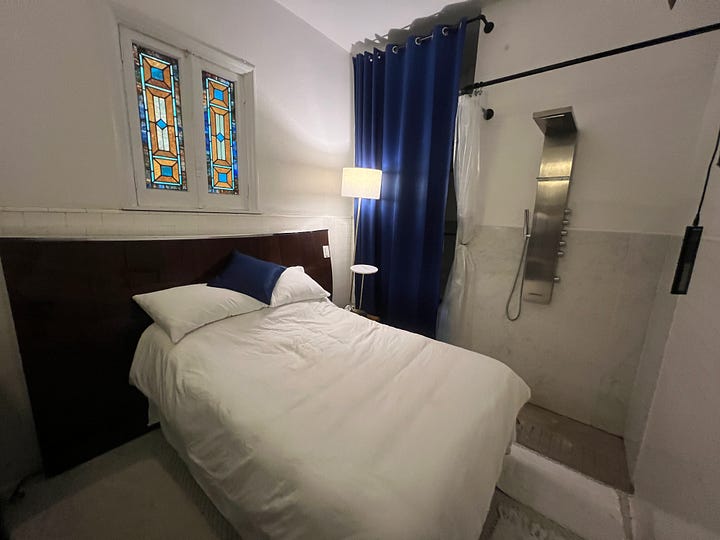
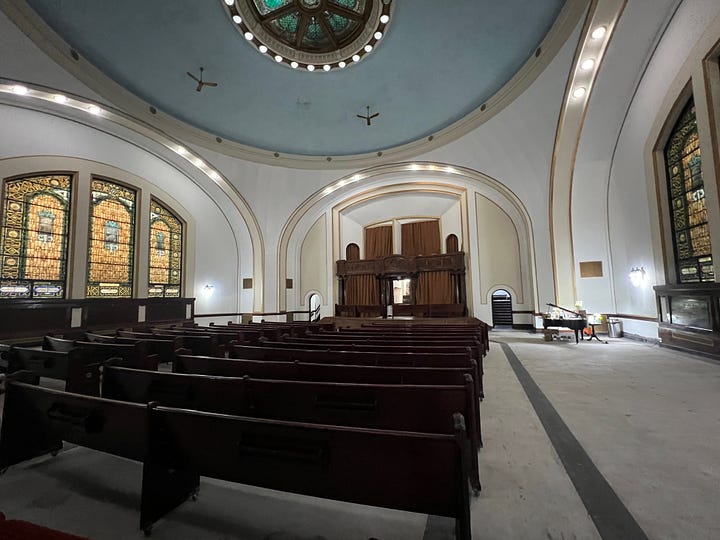
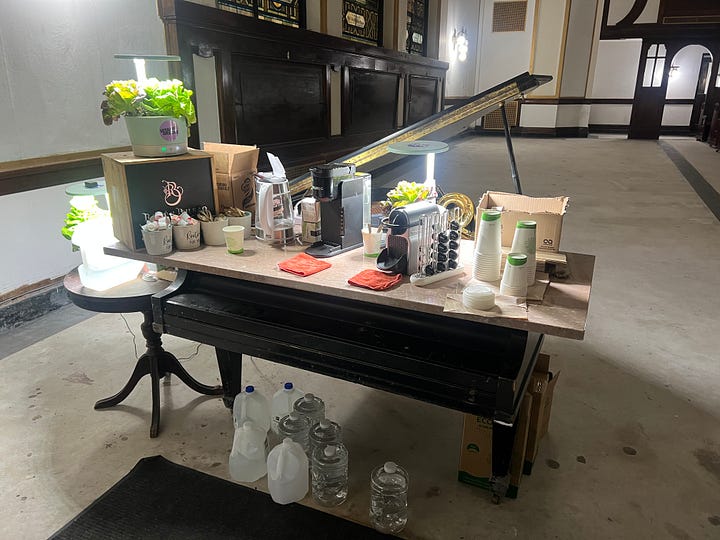
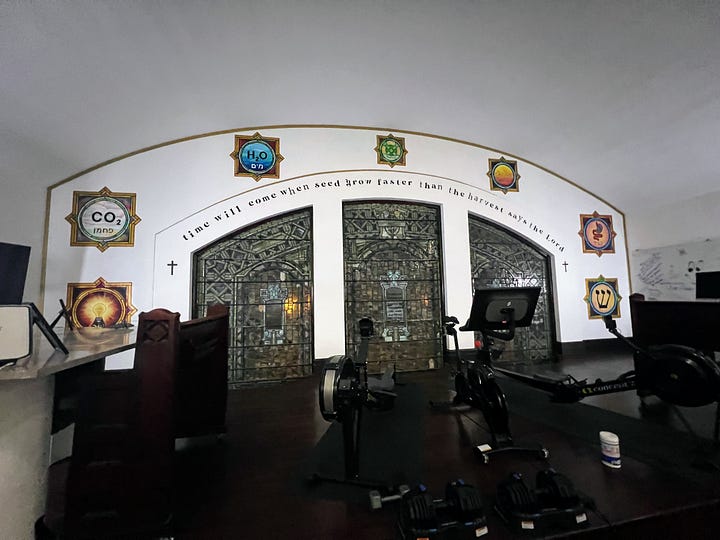
I wanted to know more, and to find the advertised rooftop terrace, but I was hungry. I’d put out feelers on my socials, asking anyone who knew the area for recommendations. I wasn’t in the mood for Buffalo Wings, despite being in their eponymous birthplace, but a suggestion that I try “Beef on Weck” led me to look for a place where I could find one of the local signature roast beef sandwiches on a gluten free roll.
The top spot, it turned out, was just half a mile from my room.
It was still raining, so I opted to drive rather than walk. After 20 minutes looking for street parking, I finally got to The Place.
That capitalization isn’t an accident. The restaurant was called, “The Place.” According to a stained glass window above the door to the left of the bar, it had been there since 1941.
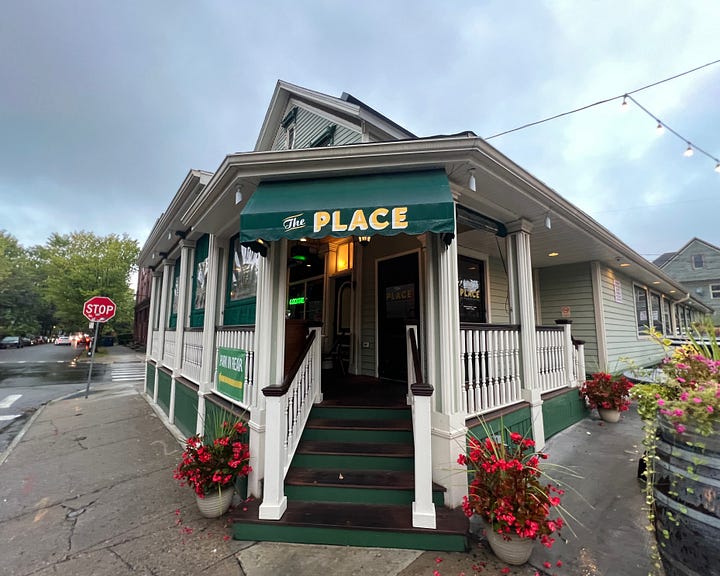
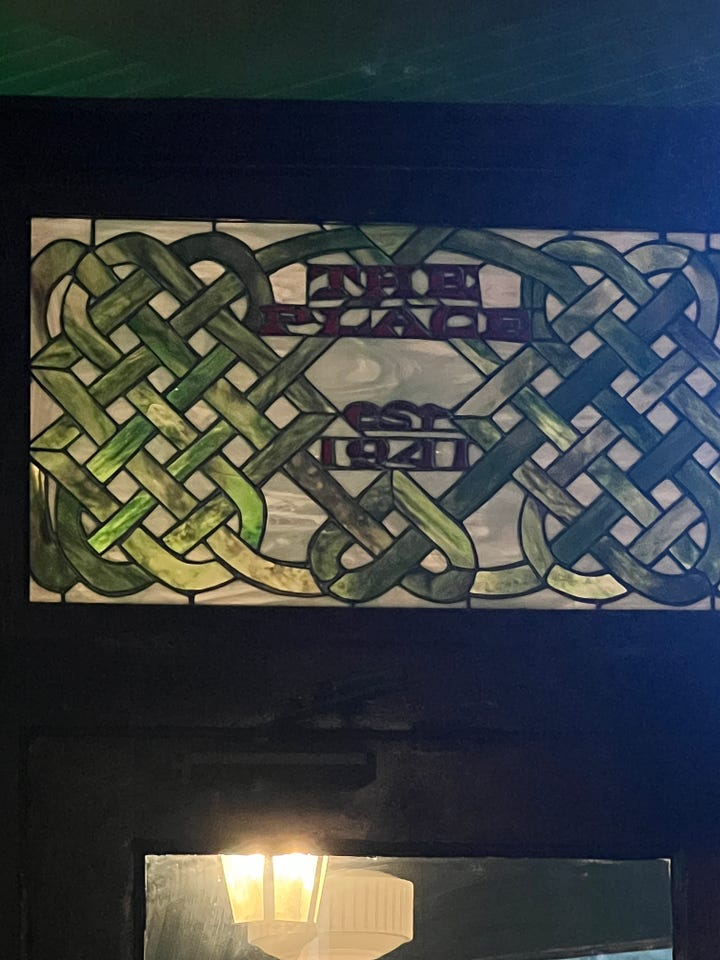
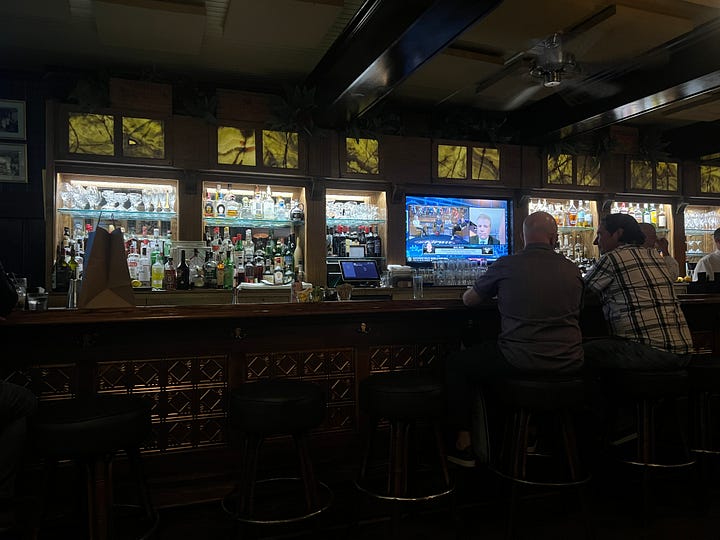
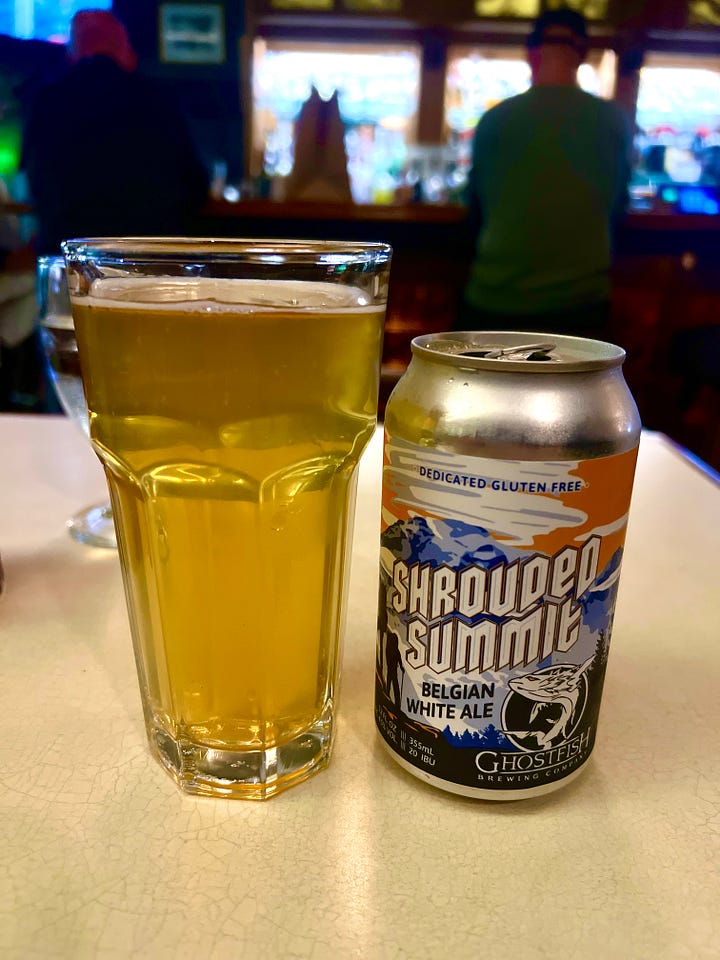
Inside, it was dark and loud, the majority of tables lined opposite a long wooden bar, stained a deep mahogany hue and plated along its length with copper-colored stamped metal sheeting. The overhead fixtures were dim and dingy, so most of the light came from the backlit liquor alcoves, punctuated by the glow of flatscreen televisions, tuned to different news channels and sporting events. I was seated and given a menu, but I knew what I’d come for, and didn’t deliberate for long.
It wasn’t overly crowded, but the service was fairly slow. As I waited there, bored of looking at my phone and with no one to talk to, I was suddenly struck with the unbearable melancholy of eating dinner alone.
I don’t typically think twice about a solo breakfast, or even a lunch, but there’s something about that last meal of the day, more than any other, that feels as though it should be taken communally. It’s a time to connect, and talk, and share the discoveries of the day. When that’s not possible, the silence is almost deafening. I had spent the past two weeks eating dinners with friends, and this was the first time facing an empty chair on the other side of the table.
I hated every minute of it.
When my food came, it looked promising, and my appetite kicked in before I thought to take a photo for this post. Which is probably for the best, because the image before me was a bit of a lie.
If you’re unfamiliar with gluten-free baked goods, their key characteristic is their structural incoherence. Even when they taste great, almost all non-gluten baked goods have a tendency to completely fall apart. Gluten is a unique protein that provides elasticity to dough that gives it chewy consistency and coherence and texture in a way that nothing else can. It is a cruel irony that it also provokes a very unpleasant autoimmune reaction in people like me, because it’s absolutely wonderful if you can digest it without incident.
My roll was toasted, and seasoned, and it looked picture perfect right up until I picked up my sandwich to take a bite. That was when everything came unglued. Chunks of bun began falling everywhere, crumbs ricocheting across my shirt and the table upon impact. Making matters worse, the roast beef was over-cooked. The horseradish was grated, when it would have been better served in a cream sauce that might have added some much needed moisture and mouthfeel to the well-done beef. The thimble full of provided au-jus was barely enough to do more than dampen things a little. The truffle fries, which I’d paid extra for as an upgrade, were overdone, and didn’t taste at all like truffle anything. The beer was from a dedicated gluten-free brewery I’d heard good things about and had always wanted to try, but it was a barely-palatable mishmash of flavors that was only pleasant for the first couple of sips, and went downhill in a screaming fit of funky Belgian yeast esters from there.
Before long, the detritus from my sandwich was just embarrassing. I kept trying to clean myself and the table up before someone started giving me the stink eye. You’d have thought I’d been eating with a Tasmanian devil on my lap. I didn’t make it half way through the meal before being reduced to spearing pieces of bread and meat together with a fork at my little table in the dark.
The Place was stuffy and warm, and even after taking my sweatshirt off, something about the meal brought a flush to my face that was almost as uncomfortable as the loneliness I was feeling. I finished up and hurriedly paid. It was a huge relief when I exited into the cool autumn air, my hoodie still off and draped over my arm. The drizzle had finally stopped, so I took my time enjoying the night as I slowly walked the two blocks to my car.
I drove around for a bit, picking up some ice for my cooler and some other items I needed, then headed back to my room. I decided to go looking for that rooftop terrace, which turned out to be at the top of a staircase so narrow and steep that it was essentially a ladder. My shoulders barely fit through the opening at the top. Coming back down was twice as harrowing as going up.
But the view from up there was fantastic. I fired up my drone, and took it for a spin:
There’s so much incredible architecture in Buffalo, it doesn’t take much imagination to envision what a stunning town it must have been in its heyday. Even worn down by time and weather, there are incredible homes and buildings everywhere, and the tree-lined streets are charming and lovely to look upon.
Sadly, like most of the Rust Belt cities, Buffalo has taken a lot of damage. I saw boarded up homes and abandoned buildings interspersed throughout otherwise normal neighborhoods. Transients appeared common, and I encountered multiple people with obvious mental illness on that otherwise average Tuesday night.
At last, I retired to my room, where I re-watched a couple episodes of a favorite police procedural I hadn’t seen in years, and tried without success not to think about how strange it felt to be in an unfamiliar city alone. Eventually, sleep came, but not without effort.
In the morning, I packed up, and spent 20 minutes trying to figure out how to work the shower with its half-dozen knobs and spouts, all while hoping to keep the water contained within the curtain — the only barrier between it and the bed.
I’m not even going to talk about the ten minute invasive experience that resulted from my inability to figure out how to turn off the bidet using the hieroglyphs on the provided remote. I almost had to call 911.
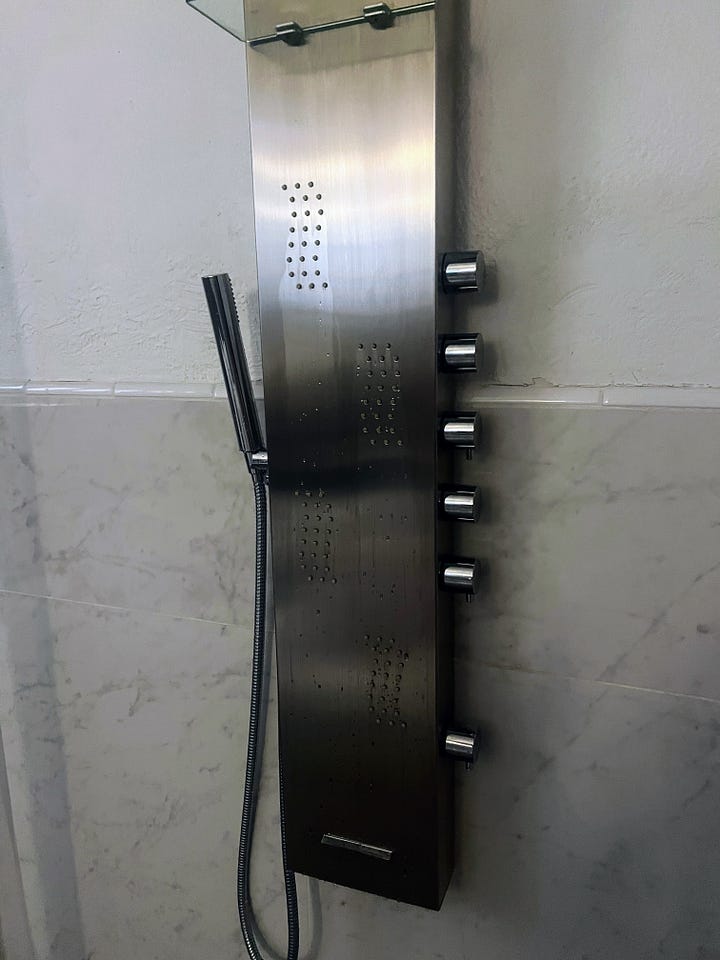
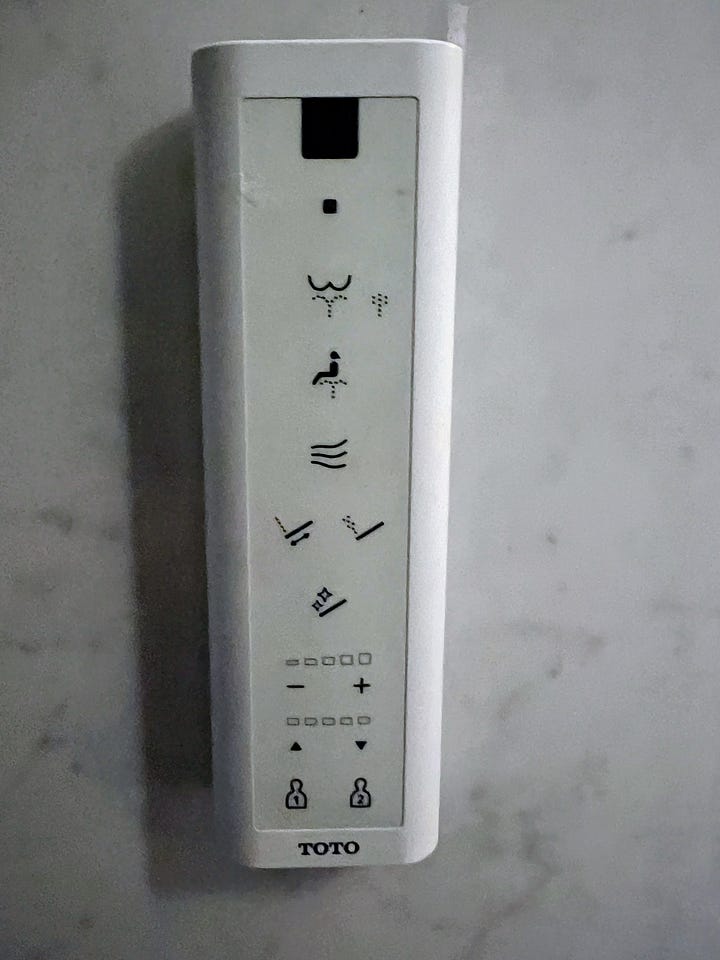
Cleaned up and packed, I checked out, and made a beeline for the first highly-reviewed coffee shop I could find. I ordered a hot latte and did a little writing outside in the chilly morning air until my laptop battery gave out.
By then, I was getting hungry for real food. I am an absolute sucker for the classic diner breakfast experience, so I searched for somewhere I could grab some chow before getting back on the road. As it turned out, there was a place not too far away called the Swan Street Diner, located inside an original Sterling Streamliner car built by the J.B. Judkins Company in 1937.
Oh yeah.
I made my way downtown on a beautiful morning, and found plenty of parking. Before heading inside, I had to stop and admire the view. The place was incredible - and immaculate.
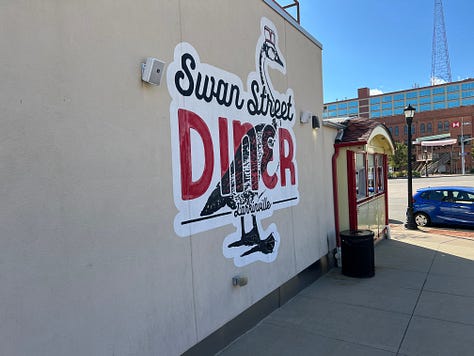
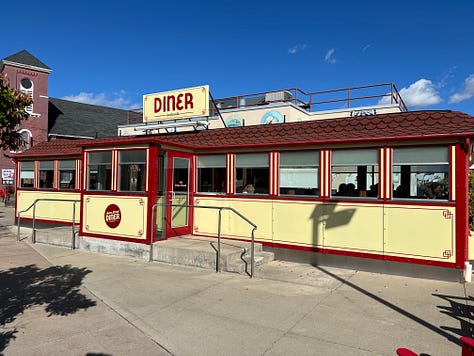
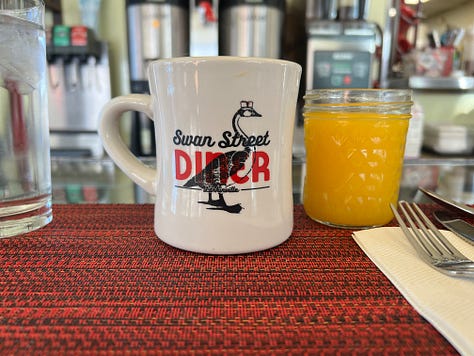
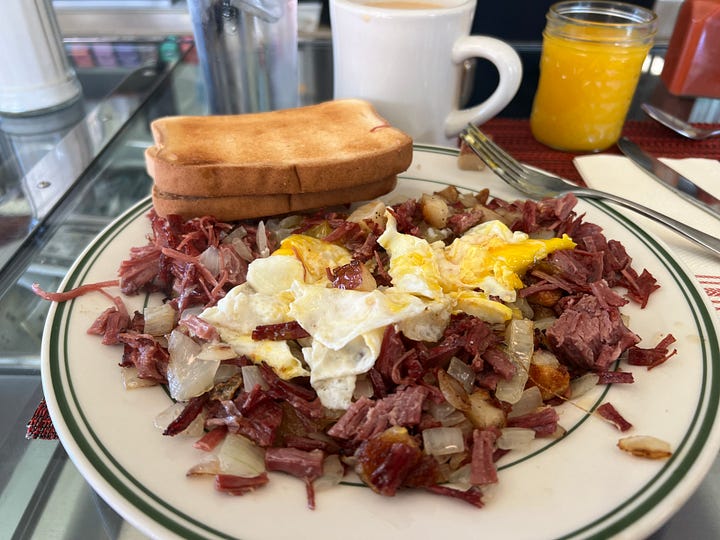
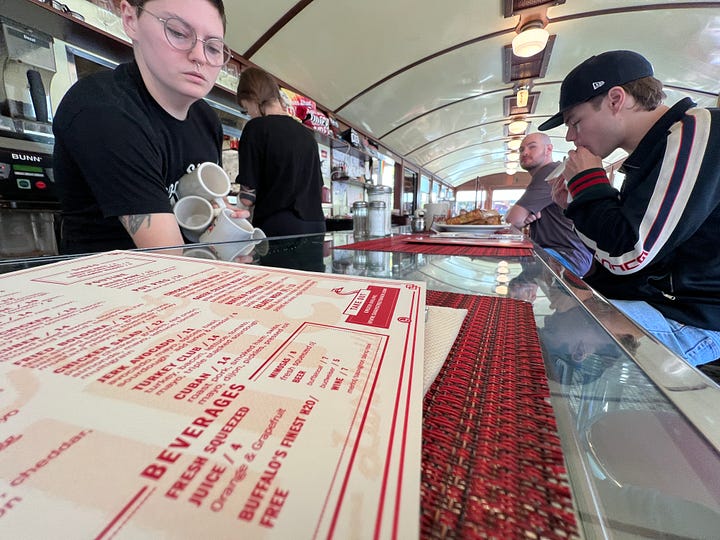
I grabbed more coffee, a little fresh-squeezed OJ, and a plate of corned beef hash with two eggs, over easy. They even had gluten-free toast. The service was fast, the food was incredible, and the guy behind the counter reminded me of a young Matthew McConaughey without the Texas drawl. The timbre of his voice even sounded eerily similar. He never stopped hustling for even five seconds the whole time I was there, but he looked to be enjoying himself. At one point, he finished pouring a bag of fresh coffee beans into a hopper and then buried his face in the bag.
“Man, I don’t know what it is, but decaf coffee smells so good,” he said with a delighted smile.
He offered a whiff to the other two customers at the counter. They each took a hit. Then he turned to me.
“Eh?” he said, tipping the bag my way.
I obliged. It smelled…like coffee. But his enthusiasm was infectious.
Fueled up and ready to go, I asked for my coffee refill in a to-go cup, then headed out onto the open road.
Next stop: Michigan, to meet up with the priest known as Joe in Black.
If you liked this essay, please consider subscribing—or send a tip (Venmo/Paypal/Stripe) to support this and future pieces like it.



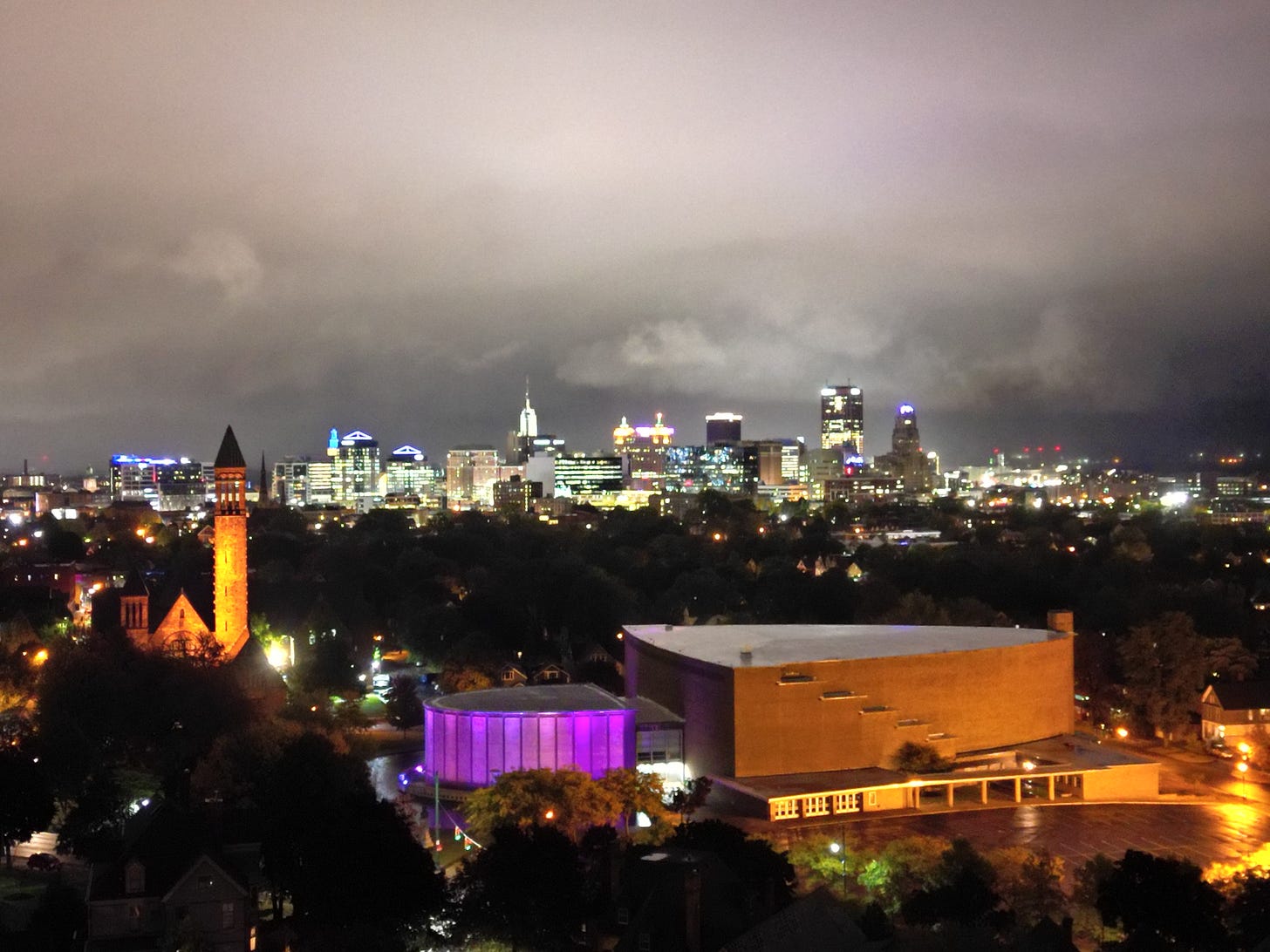
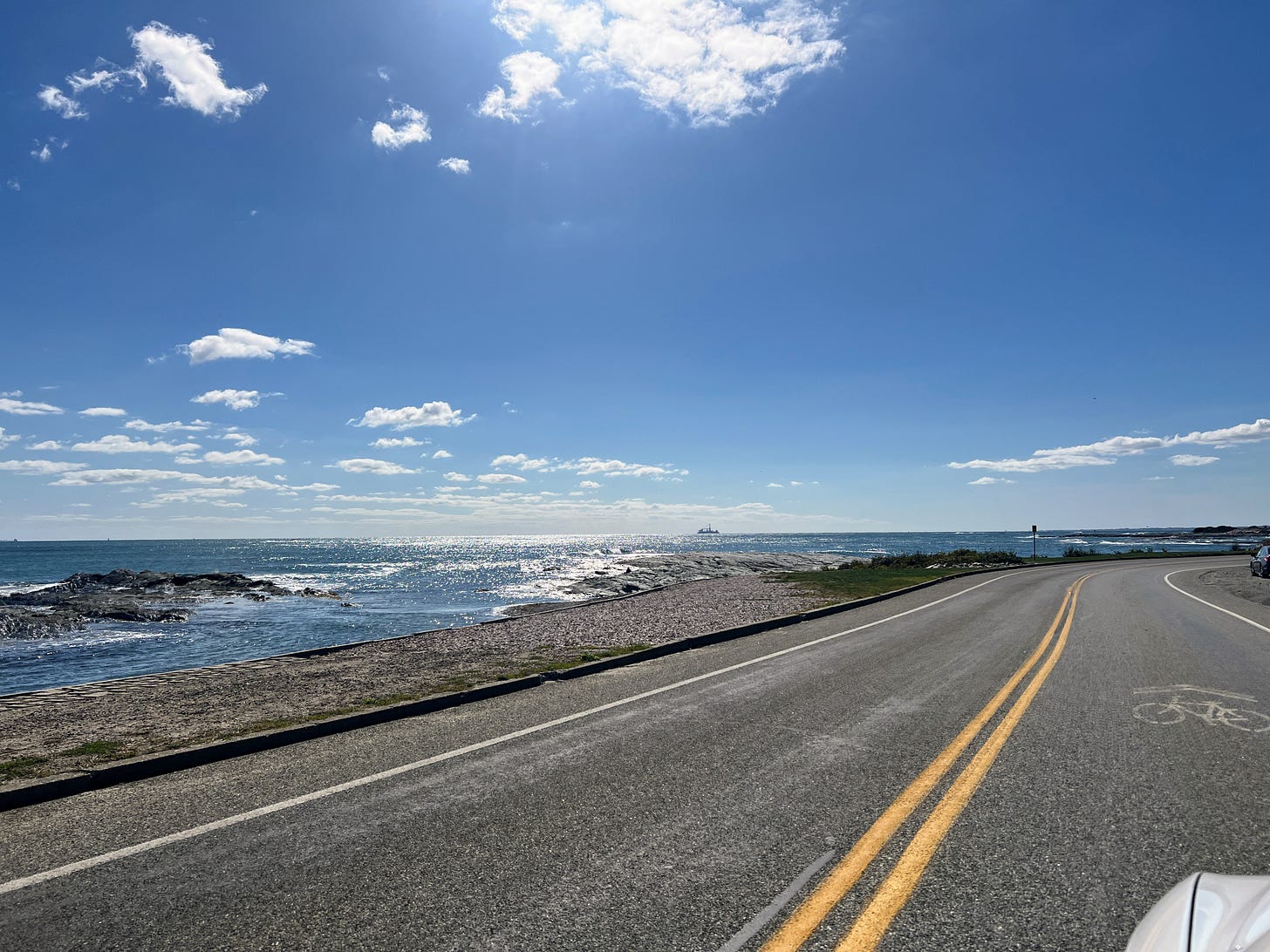
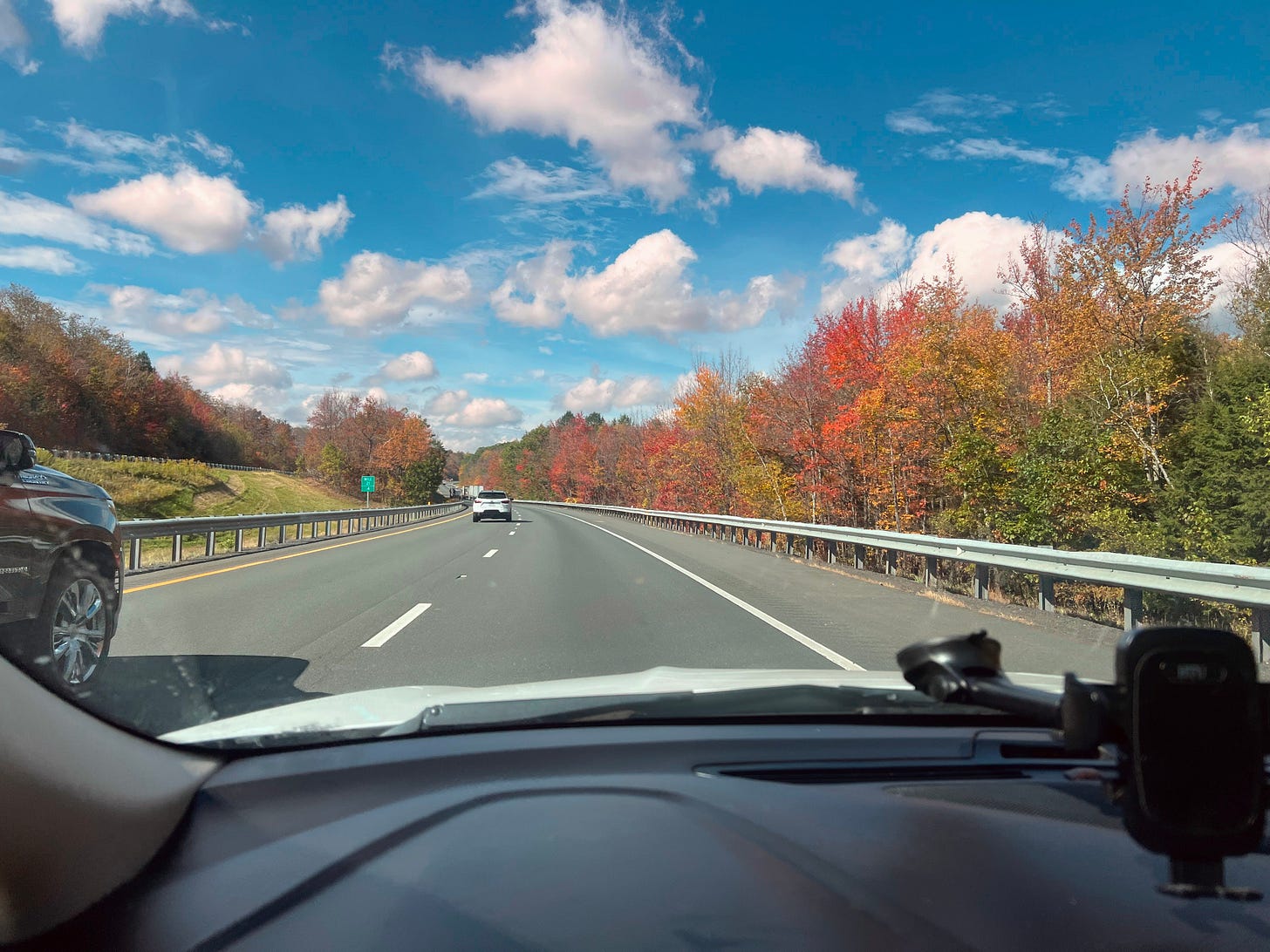
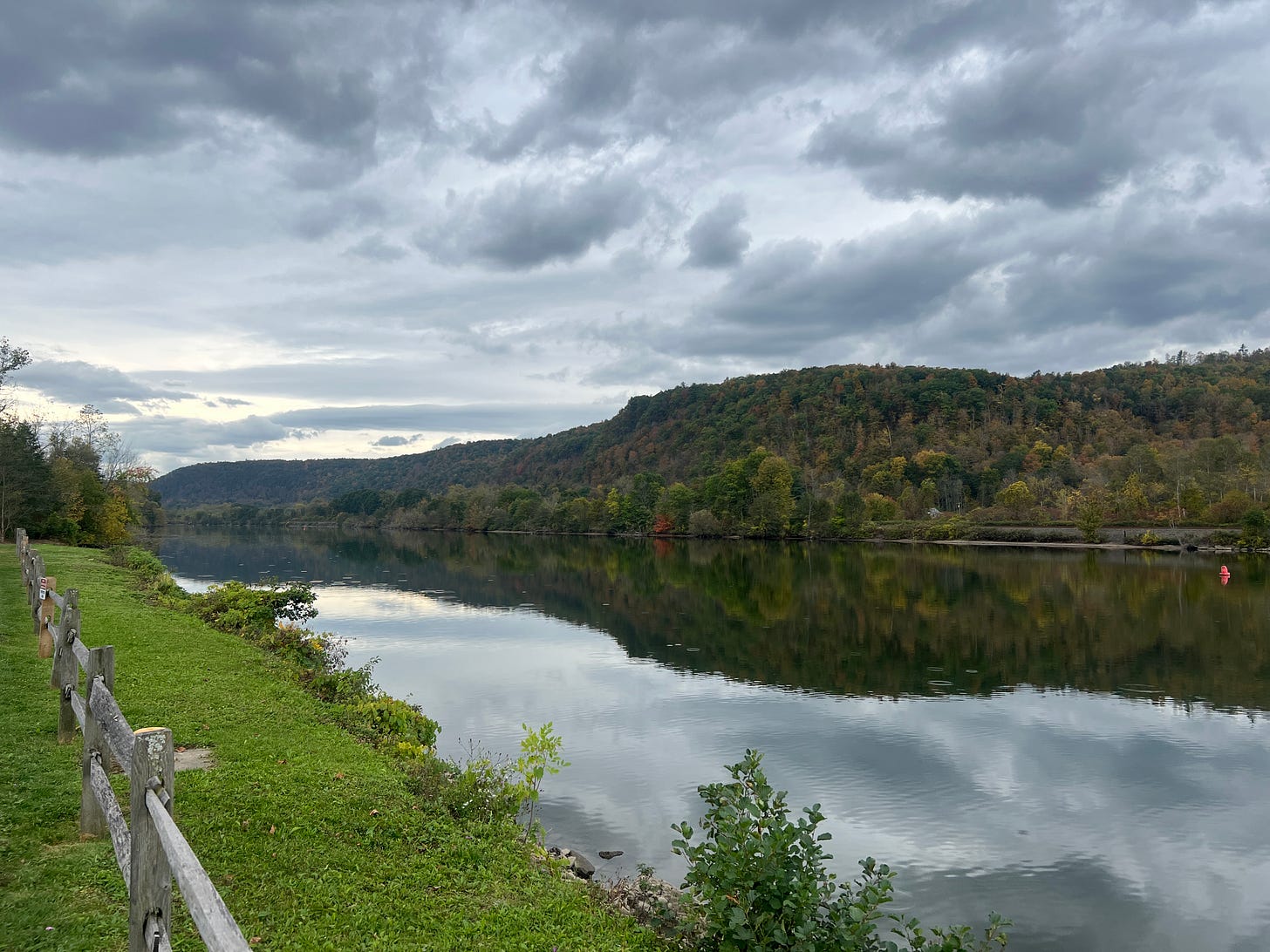
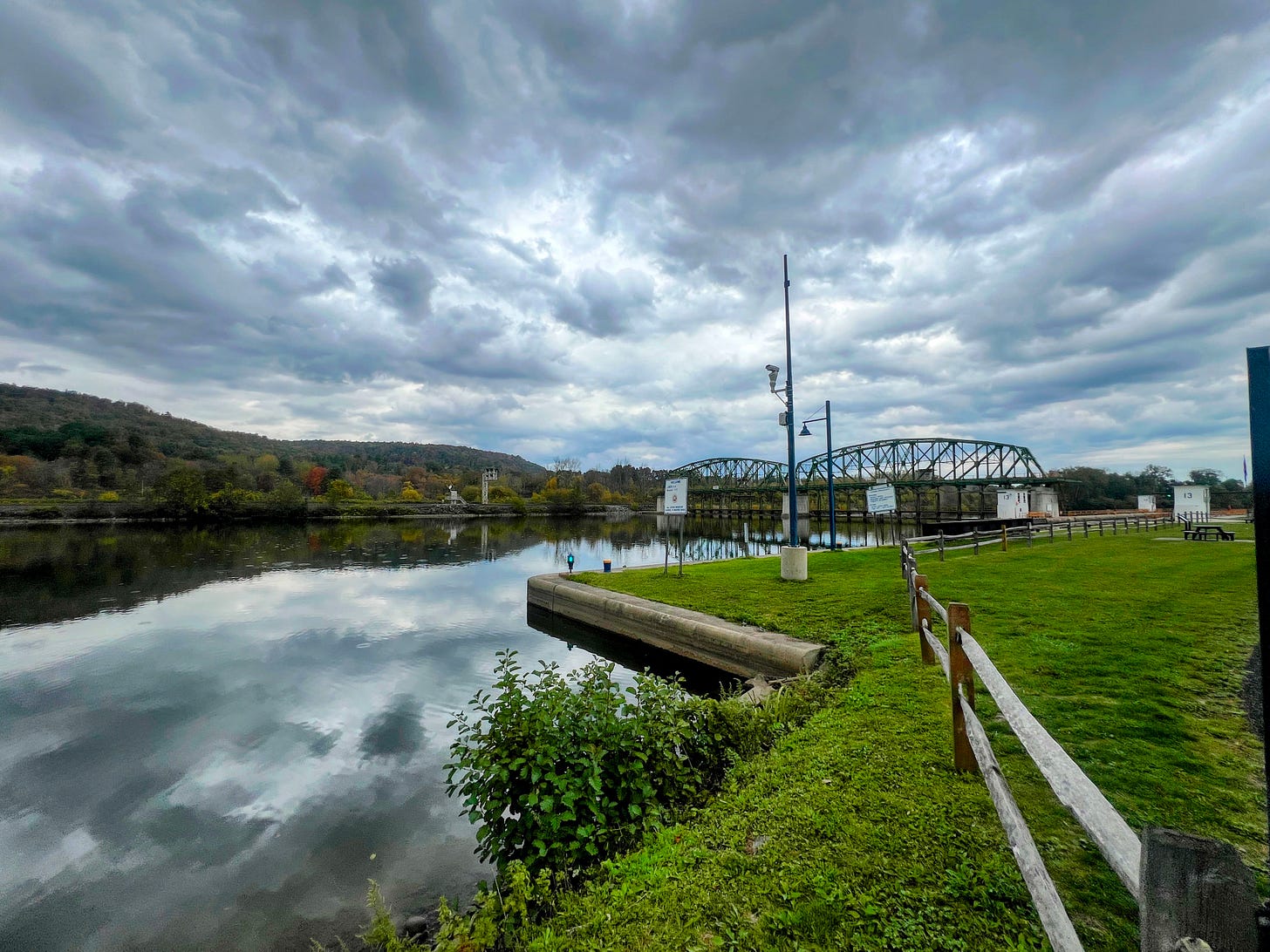
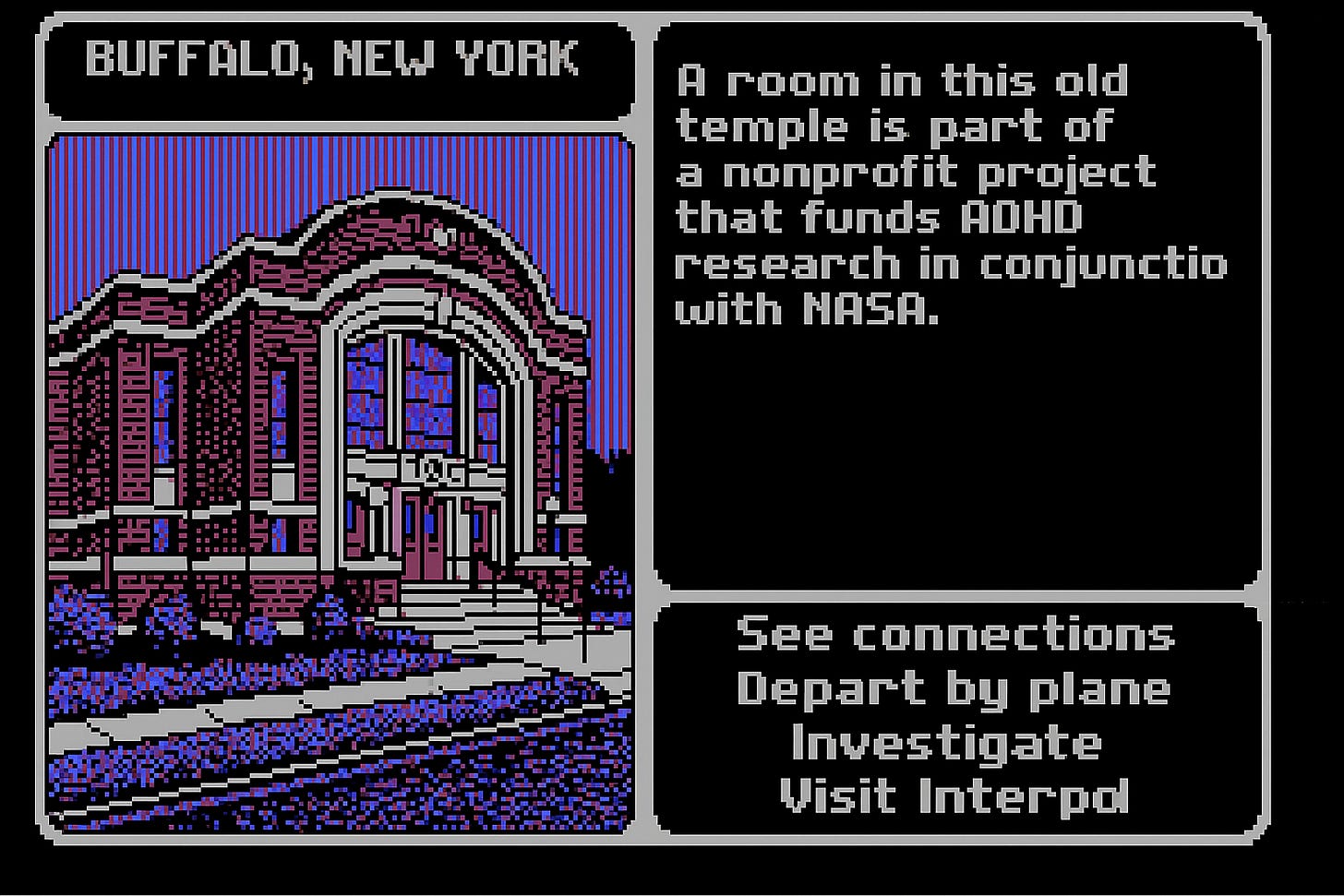
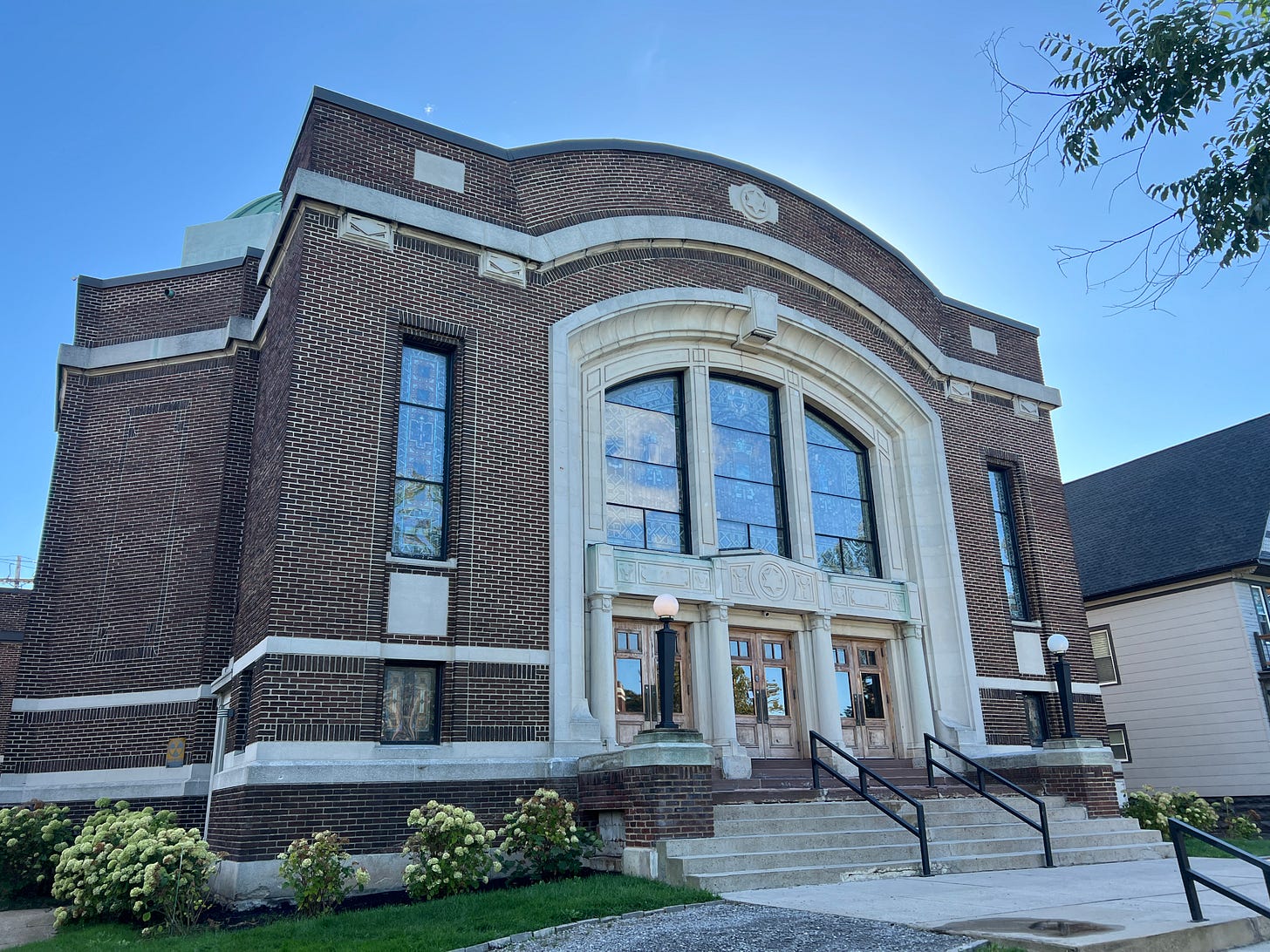
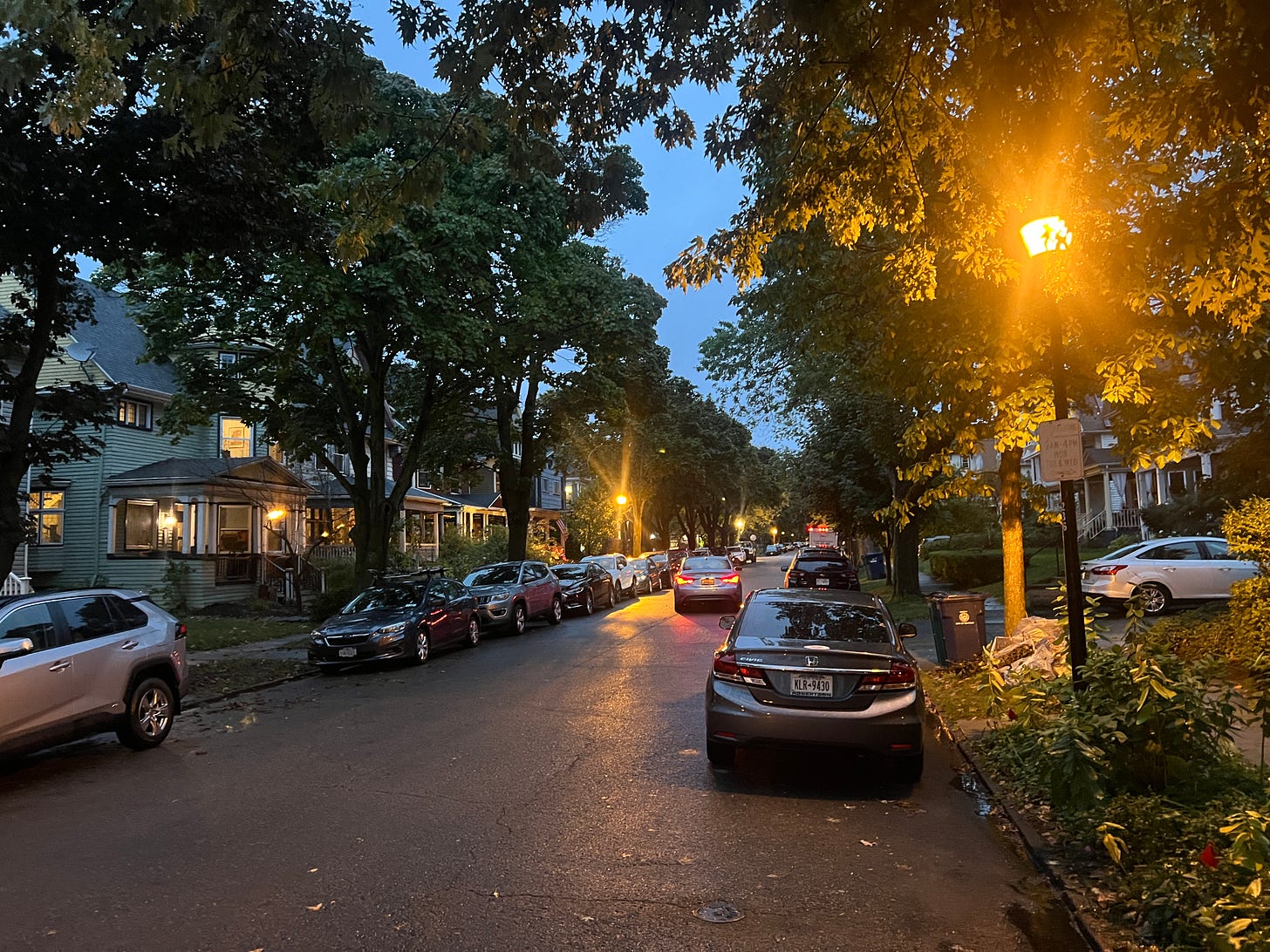
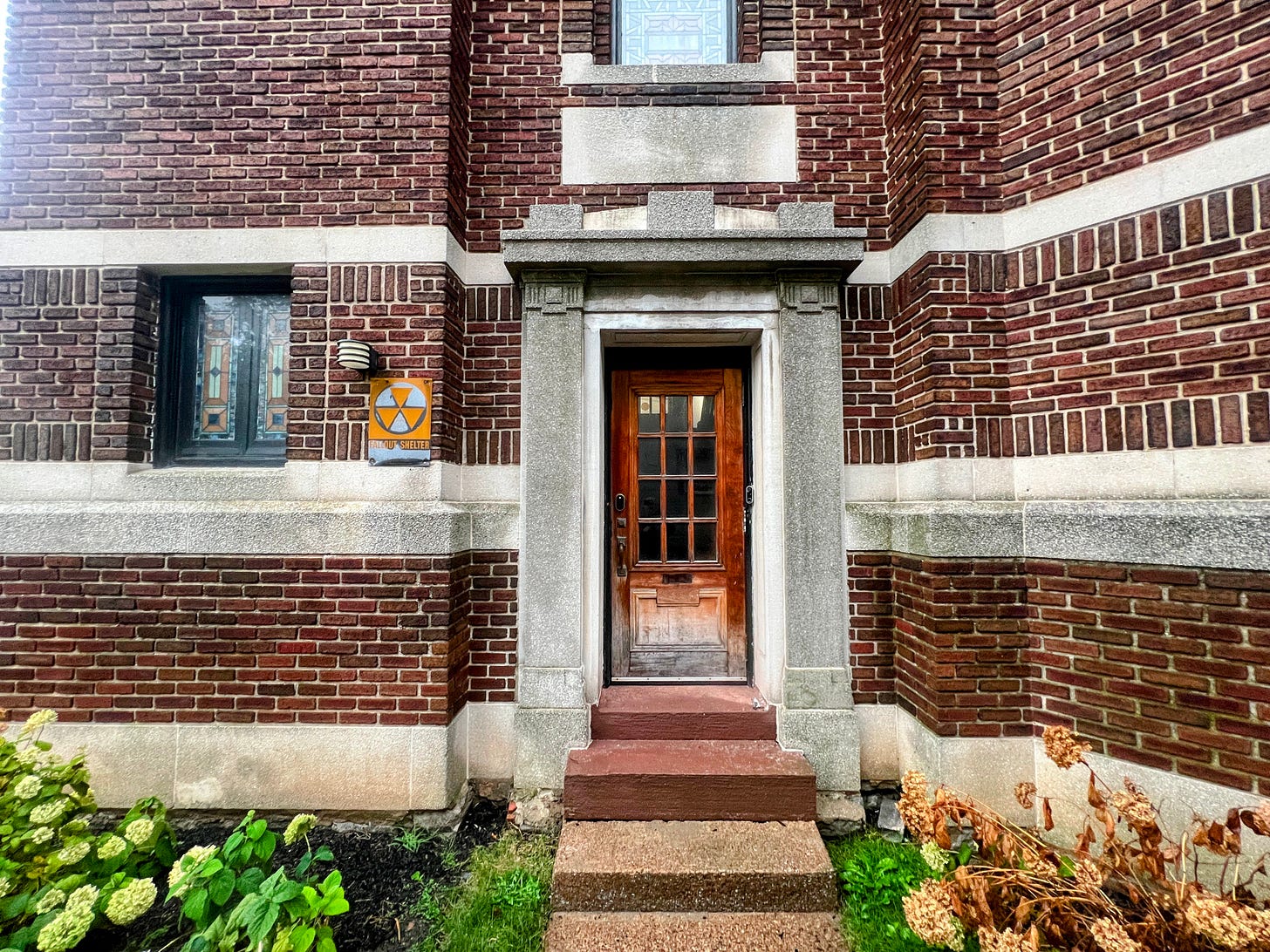
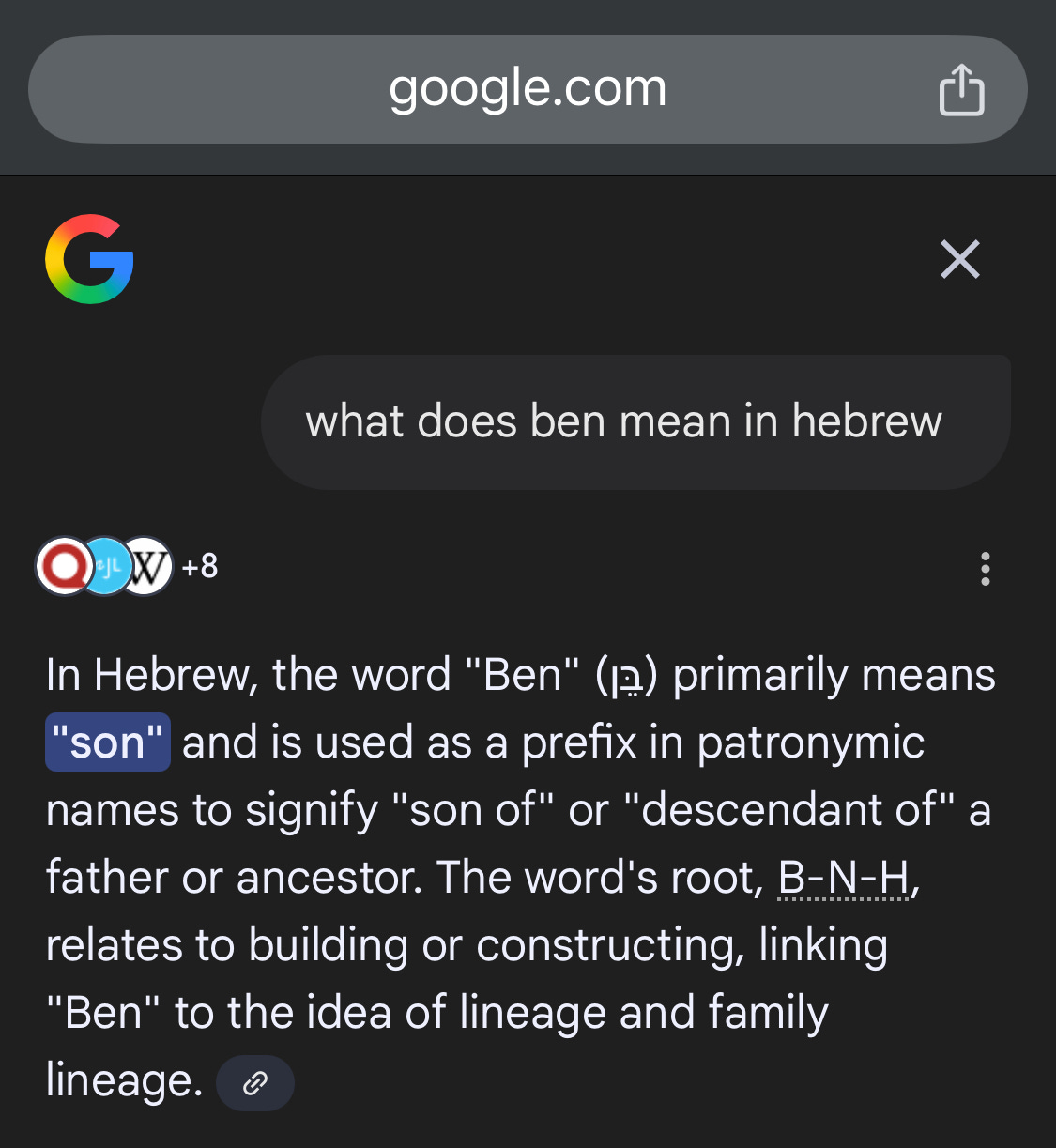
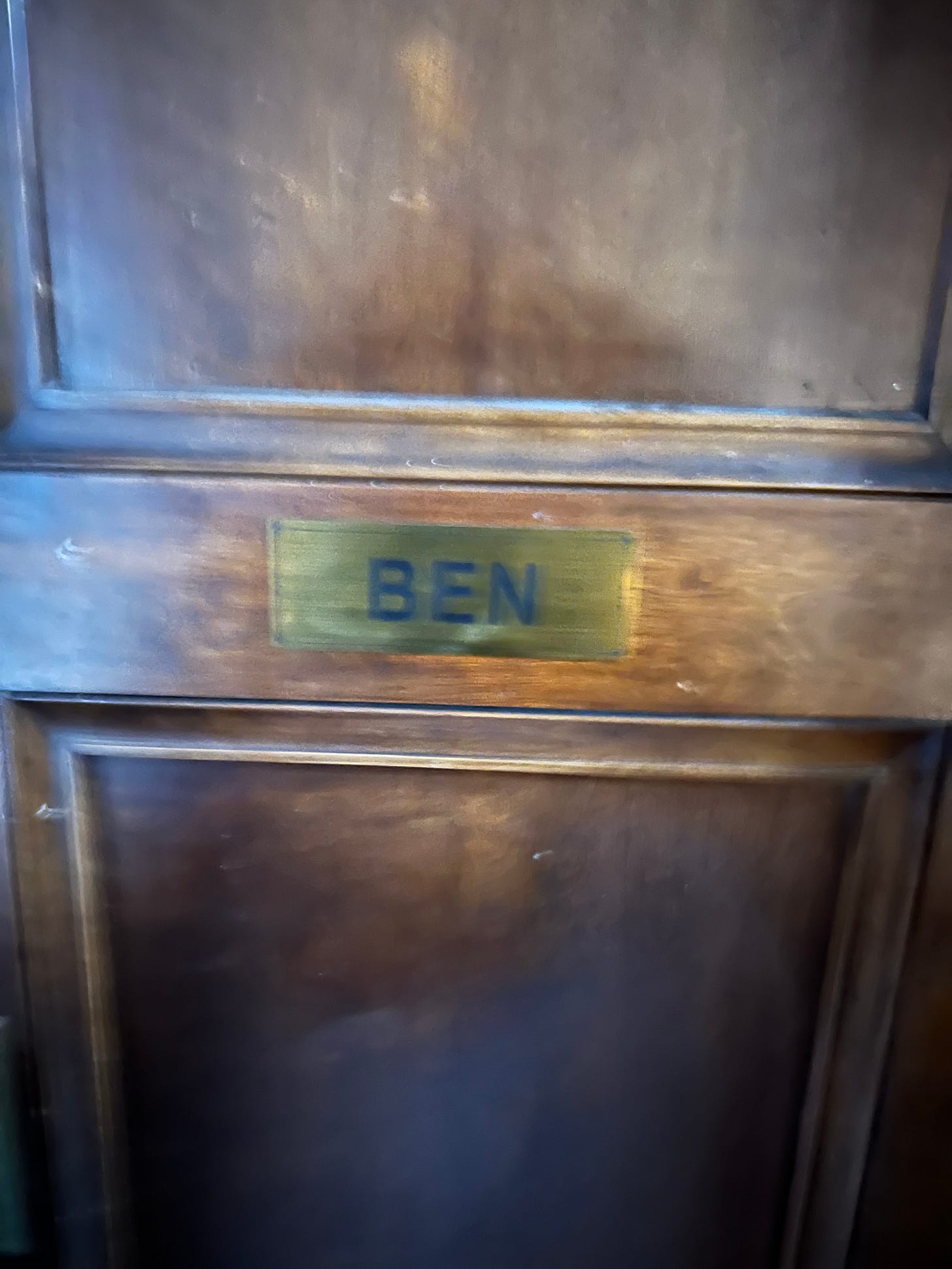
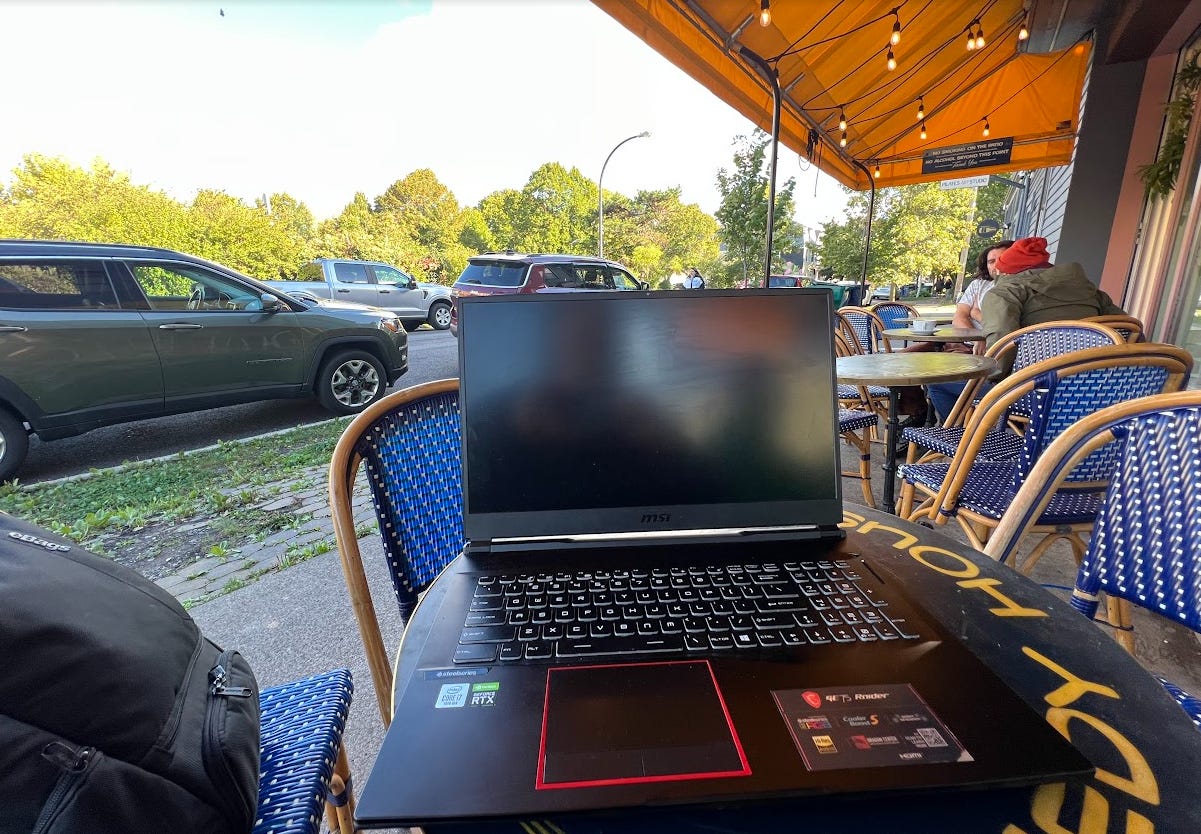
Steve,
As I sat down alone on the couch to eat what an old lady eats when she has no teeth, I decided to read your post.
Truly, I was so transported by word to your world that for those minutes, I forgot how horribly miserable my current existence is.
I laughed out loud during certain parts and before I knew it, my dinner on the couch was over. You made my day.
We had dinner together tonight and I so enjoyed it.
So glad to hear you’re going to see Joe in Black! Appreciate the posts from the road.